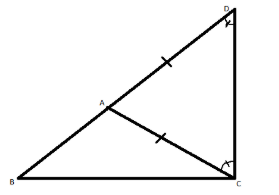
Sum of two sides of a triangle is …………. than the third side.
(A). Greater
(B). Lesser
(C). Equal
(D). May be greater or lesser
Answer
522k+ views
Hint- In order to deal with this question first we will make a diagram then by extending the side of a triangle we will use the property of isosceles triangle, use this property to get the answer.
Complete step-by-step answer:
Let ABC be a triangle

We can extend BA past A into a straight line.
Then there is a point D such that DA = CA
Therefore, from isosceles triangle has two equal angles,
Thus, in
Thus,
The sum of any two sides of the triangle is greater than the third side and the correct option is “A”.
Note- In order to solve these types of questions, remember the theorems and properties of triangles. Also the concept of parallel line and angles. To prove the above theorem we use the isosceles triangle. We can also take an equilateral triangle to prove as we know that all sides of the equilateral triangle are equal therefore the sum of two sides is twice the third side. Hence, the sum of two sides of the triangle is greater than the third side.
Complete step-by-step answer:
Let ABC be a triangle

We can extend BA past A into a straight line.
Then there is a point D such that DA = CA
Therefore, from isosceles triangle has two equal angles,
Thus, in
Thus,
The sum of any two sides of the triangle is greater than the third side and the correct option is “A”.
Note- In order to solve these types of questions, remember the theorems and properties of triangles. Also the concept of parallel line and angles. To prove the above theorem we use the isosceles triangle. We can also take an equilateral triangle to prove as we know that all sides of the equilateral triangle are equal therefore the sum of two sides is twice the third side. Hence, the sum of two sides of the triangle is greater than the third side.
Recently Updated Pages
Master Class 12 Economics: Engaging Questions & Answers for Success

Master Class 12 Maths: Engaging Questions & Answers for Success

Master Class 12 Biology: Engaging Questions & Answers for Success

Master Class 12 Physics: Engaging Questions & Answers for Success

Master Class 4 Maths: Engaging Questions & Answers for Success

Master Class 4 English: Engaging Questions & Answers for Success

Trending doubts
In Indian rupees 1 trillion is equal to how many c class 8 maths CBSE

List some examples of Rabi and Kharif crops class 8 biology CBSE

How many ounces are in 500 mL class 8 maths CBSE

What is the feminine gender of a stag class 8 english CBSE

Give me the opposite gender of Duck class 8 english CBSE

Summary of the poem Where the Mind is Without Fear class 8 english CBSE




